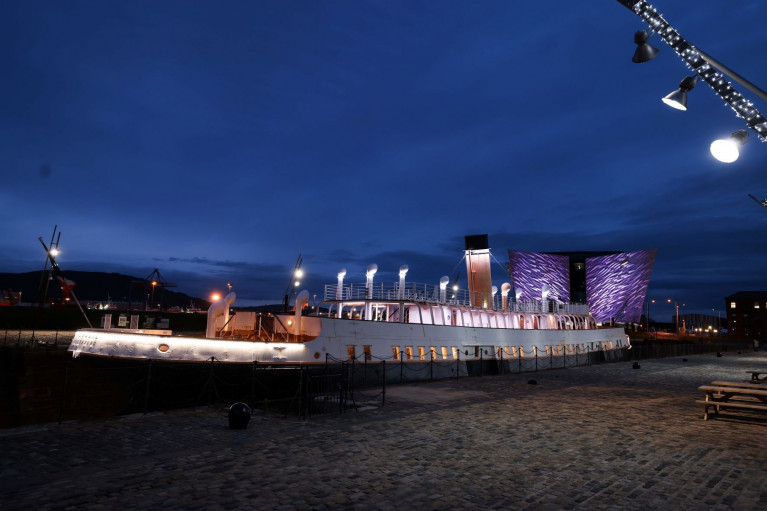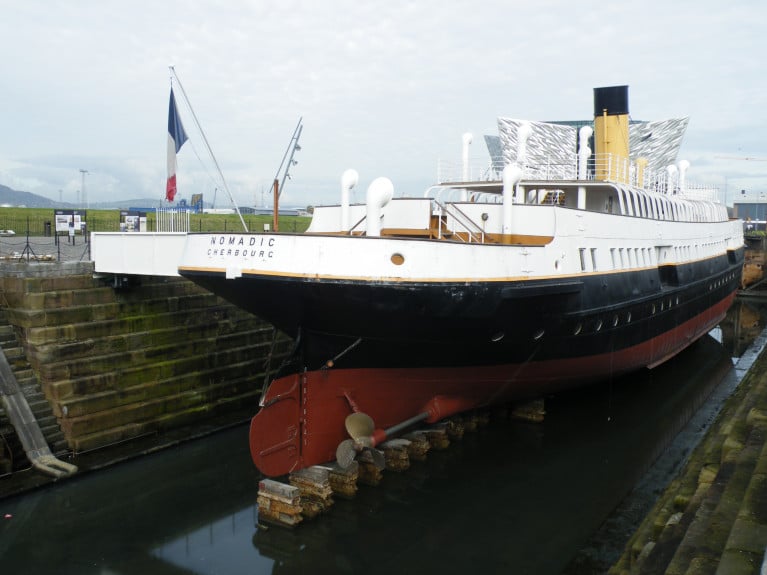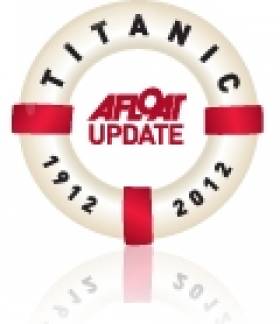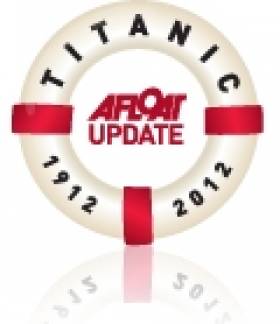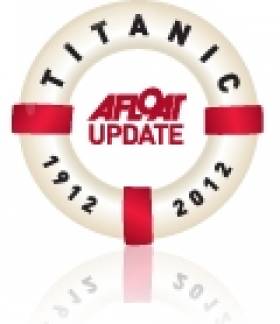Displaying items by tag: SS Nomadic
Harland & Wolff Works to Preserve Maritime Heritage By Restoring SS Nomadic Paintwork
The charity responsible for preserving Belfast’s maritime and industrial heritage, Maritime Belfast Trust which owns the tender RMS Titanic, have brought Harland & Wolff shipyard on board to give the ship that they completed in 1911 a new coat of paint.
SS Nomadic served as a tender to RMS Titanic from the French port of Cherbourg and is a quarter of the size of the iconic passenger liner, with many of the same ornate features and finishes.
As the last remaining White Star Line ship, SS Nomadic requires continuous maintenance and restoration. Harland & Wolff has carried out various works on the ship since it returned to Belfast in 2011. These works include, reinstating the bridge deck, flying bridge desk and the funnel, and repairs to the keel blocks.
Admission to SS Nomadic is now included in the Titanic Experience ticket, giving Titanic Belfast’s visitors the chance to step onboard, with public access to the ship maintained while works are ongoing.
Highlighting the work as an important part of Belfast’s history, Kerrie Sweeney, chief executive of Maritime Belfast, said: “The SS Nomadic is such a significant part of Belfast’s maritime heritage and we are delighted to have appointed Harland & Wolff to support its ongoing conservation.
For further coverage, the News Letter reports on the restoration work.
New Feature Sees Lights Shine on SS Nomadic's History
A new outdoor lighting feature has been installed on the historic SS Nomadic, providing a new lease of life on the decks of the liner-tender on view at Titanic Belfast.
The project was launched as part of Local History Month celebrations, shining a spotlight on the iconic SS Nomadic which is the last remaining White Star Line vessel.
The £91k investment came from a collaborative partnership by Tourism Northern Ireland and owners of the vessel, Maritime Belfast Trust. The project was undertaken by Anthony Hayes of AH Design, a company with over 30 years’ experience in building services specialising in lighting design.
The completed installation uses accent lighting to elegantly illuminate the ships decks, funnels and gangways. The lights are versatile and can be changed in colour.
These will be co-ordinated with Titanic Belfast’s pre-existing illumination schedule, marking important calendar dates and key local, national and international events.
For further reading from Maritime Belfast in addition to a link on the history of the SS Nomadic.
Maritime Heritage in NI Where SS Nomadic & Titanic Belfast Receive Covid Recovery Grants
The tender that served RMS Titanic at Cherbourg, France, which forms part of the liner's visitor attraction centre in Belfast Harbour, have both received £1.63m from a total £5m plus funding from the UK's Heritage Recovery Fund, writes Jehan Ashmore.
According to the National Historic Ships UK, the funding awarded to the tender SS Nomadic and Titanic Belfast, is to support the recovery and reopening of the centre, as well as protect the future of its heritage – a significant driver of global tourism and economic growth for Northern Ireland.
SS Nomadic, capable of 1,000 passengers, divided into three classes, was purpose built for the White Star Line and is the last remaining ship from the company, which highlights the historic story of Belfast’s maritime heritage and as the biggest Titanic artefact.
Designed and built by Harland and Wolff in 1910-11, the SS Nomadic has many of the same luxurious finishes as RMS's Titanic / Olympic, and is a quarter of the size. The tender was also designed to transport luggage and stores to and from the liners anchored offshore.
In addition the funding, totalling more than £5m was awarded to other heritage organisations including the National Trust NI and Creggan Country Park along with self-employed tour guides, stonemasons, coppersmiths and conservators.
The awards aim to safeguard jobs for the long-term and enable recipients to adapt and prepare for reopening or restarting work when restrictions permit.
“The risks to historic sites, attractions and essential heritage jobs and skills from a sudden and dramatic loss of income as a result of the pandemic, have put the heritage and visitor economy in crisis, and we hope this funding will play a vital role in their recovery,” states Paul Mullan, director, Northern Ireland, National Lottery Heritage Fund.
He added “Heritage has an essential role to play in making communities better places to live, creating economic prosperity and supporting personal wellbeing. All of these are going to be vitally important as we emerge from the current pandemic.”
SS Nomadic: Maritime 'Dry Docked' Heritage
Following the White Star career, SS Nomadic, saw active service in both World Wars as a troop carrier. Nomadic also tendered thousands of passengers to the world’s great liners also in Cherbourg, to serve the 'Cunarders' Queen Mary and Queen Elizabeth. This was followed with the tender becoming a Paris based restaurant and party venue on the bank of the River Seine.
Fortunes changed and the Nomadic relocated downriver, having languished for decades in Le Havre, when enthusiasts became aware of its plight, and began a campaign to ‘Save the Nomadic’ from scrappage. This ultimately led to the tender's towed return to Belfast and with shipyard origins where the veteran vessel underwent a major restoration project.
Find out more about the 'Shipshape' Network Northern Ireland zone 'here'.
Dublin's Grand Canal Dock (Basin) Graving Dry-Docks
As for Ireland's maritime heritage, Afloat previously reported last week, where in the case of Dublin, Waterways Ireland plan to sell off the historic graving dry-docks in the Grand Canal Basin. As also reported in 2016, the saved 'Georgian' dry-docks, along with a rare surviving historic Irish built ship, aptly constructed in the capital, Naomh Éanna remains in the larger dry-dock which links the Inland Waterways.
The former Aran Islands passenger, cargo and livestock ferry, was then also saved from scrapping following a petition. This led to plans for a new static role as previously reported. The last ship to serve the Aran Islands directly from Galway was Oileáin Árann (see in Icelandic waters).
In recent years, Dublin's other dry-docks, one dating to the 1950's (last year, underwent infilling) and a much older 1850's dry-dock was infilled in the Celtic Tiger era, but since further plans to excavate! As for the current scene, Afloat is awaiting an update from the port.
Restoration of Titanic’s Tender SS Nomadic Completed
#TitanicTender – S.S. Nomadic as previously reported on Afloat.ie, is a veteran of two world wars and has a direct link to the luxurious RMS Titanic past, and Charlie Chaplin and Elizabeth Taylor who have been on board the passenger liner tender.
As of today, the last remaining vessel of the White Star Line, will be open for visitors in her dry-dock next to the Titanic Belfast Visitor Centre and close to where she was launched in 1911 at Harland & Wolff.
She was built to ferry first and second class passengers to RMS Titanic from Cherbourg in France, a port too small for what was at that time the largest ship in the world. For more on this the BBC reports.
Afloat.ie adds that another former trans-Atlantic liner tender that served in Cork Harbour, (Titanic's last port of call), the T.S.M.V. Cill Airne ran from Cobh out to the liners during a short career until the early 1970's.
The Dublin-built vessel launched in the early 1960's is now a static restaurant and bar venue and is also open to visitors today and throughout the Dublin Port River Festival (1-3 June).
Titanic Memorial Cruise Heads for Cobh
#TITANIC MEMORIAL CRUISE - Following Balmoral's recent call to Belfast in memory of Titanic, the Fred.Olsen Lines cruiseship returned to Southampton where today she started a 12-night Titanic Memorial Cruise which will follow the White Star Line liner's original itinerary that included calling to Queenstown, now Cobh.
Before Balmoral calls to Cobh tomorrow, she is to pass Cherbourg, where the passenger tender SS Nomadic served the liner that layed anchored offshore. The 101 year-old tender was also built by Harlalnd & Wolff and she is undergoing restoration work in Belfast, to read more about her click HERE.
Likewise to Balmoral's Belfast visit, her arrival to Cobh is the inaugural call for this year's season, though her poignant arrival will be two days short of Titanic's call a century ago on 11th April 1912.
On Titanic's second anchorage at Queenstown, this too required tenders to transfer 123 passengers who embarked from the town's pier and of those only 44 survived the disaster. The timber built pier still exists albeit what survives is in a derelict state. There have been calls to raise funds to save the structure as previously reported.
Along the scenic waterfront passengers can take a tour of the town's new Titanic Experience in the White Star Line building, the Queenstown Heritage Story in the Cobh Hertiage Centre and the walking Titanic Trails.
From Cobh the Balmoral will sail across the Atlantic, arriving at the Titanic site on April 14th/15th - exactly 100 years on from this tragic voyage, where a memorial service will be held to pay tribute to the brave passengers and crew who perished on that fateful night.
The cruise will then continue to Halifax, Nova Scotia, the final resting place of many who were on board, before sailing on to New York, the Titanic's ultimate planned destination.
- White Star Line
- RMS Titanic
- Balmoral
- Fred Olsen Cruise Lines
- Titanic Memorial Cruise
- Cobh Cruise Calls 2012
- Belfast Port
- SS Nomadic
- Titanic's passenger tender
- Cruise ship news
- Cruiseships
- port of Cork
- Cobh Cruise Terminal
- Titanic Trails
- Cobh Heritage Centre
- White Star Line liners
- Queenstown,Ireland
- Harland & Wolff
- Nomadic Charitble Trust
Tours of Titanic’s Tender SS Nomadic
#TITANIC'S TENDER - While all the attention is focused on the R.M.S. Titanic and the newly opened Titanic Belfast visitor experience, the White Star Line passenger tender SS Nomadic is only a stone's throw away from the venue, writes Jehan Ashmore.
Like the liner she was built by Harland & Wolff and her launch took place in 1911. She was commissioned by White Star Line as a 1st and 2nd class passenger tender for Titanic and sister Olympic.
The Nomadic carried out her duties based in Cherbourg, where she transferred passengers to the Titanic on her only call to the Normandy port. As such the vessel which is registered in the French port, is the last surviving White Star Line vessel in the world and the only remaining authentic link to the ill-fated liner.
Decades later, the Nomadic became a floating restaurant on the River Seine in Paris close to the Eiffel Tower, where the venture which started in 1977 remained formore than twenty years.
The ageing vessel faced new safety regulations threatening her fate which ultimately led to her being seized in 2002. She was then offered for sale and then followed a court action for her to be scrapped but a campaign was raised to save the historic vessel which succeeded in her securement.
At 95 years old she was towed by barge back to her builder's birthplace in Belfast in 2006. Now that she is over a century old the vessel is currently undergoing restoration by the SS Nomadic Charitable Trust. She is dry-docked in the Hamilton Dock which adjoins the new iconic landmark of the Titanic Belfast building within the developing Titanic Quarter.
Yesterday 'hard-hat' tours began of the preserved liner tender and it is essential to note that tickets are to be 'pre-booked' with the last tour on 15th April. Daily tours are at 10.30, 12 noon, 2pm and the last tour is 3.30pm. To ensure availability visit: www.nomadicbelfast.com/book-a-tour
For further information about the various visitor attractions and events click the following headings, to be directed to the relevant websites.
The history of the S.S. Nomadic
Titanic Belfast Festival (31 March -22 April)
Titanic Belfast Visitor Experience
Following yesterday's inaugural cruise call to Belfast this year of Balmoral as previously reported the Fred. Olsen Cruise Lines vessel was making a cruise in memory of the liner. To see the list of the other cruiseships calling to the city, click HERE.
- RMS Titanic
- SS Nomadic
- White Star Line
- Nomadic Charitble Trust
- Harland & Wolff
- H&W
- Cherbourg
- White Star Line passenger tenders
- Hamilton Dock, Belfast
- Port of Belfast
- Belfast Lough News
- Cruise ships
- Cruise Liners
- Balmoral
- Fred. Olsen Cruise Lines
- Restaurant river Seine boats
- Titanic Belfast
- Titanic Quater
- Titanic Belfast Festival
- RMS Olympic


























